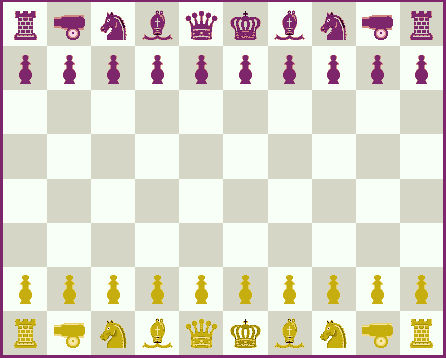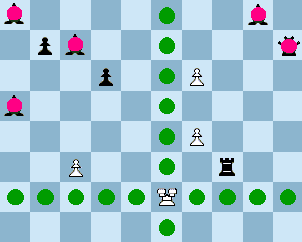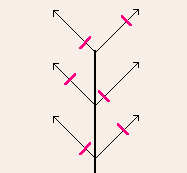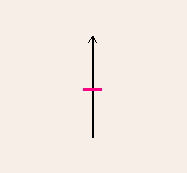

The Doublecannon is a bifurcation piece. It slides like a rook. Following the orthogonal move, it can make a capture by jumping diagonally over a piece of any colour, and land on an enemy piece positioned anywhere on the diagonal behind the jumped piece, provided that any intermediate squares are empty. The jump is performed in the prolonged movement direction only (two direction alternatives). While the Doublecannon slides along an orthogonal, several diagonals (in the prolonged movement direction) could be chosen. This makes it a quite dangerous cannon piece. The Doublecannon's value is 4, that is, between bishop and rook (preliminary estimate). Otherwise the rules are the same as in standard chess, except for the possible promotion to Doublecannon.
Although the Doublecannon loses 'screens' for jumping when the pieces become fewer, it becomes more mobile when the orthogonals are cleared from pieces. Thus it often retains its value in the endgame. Note that the Doublecannon can have a big influence from behind the friendly pawn chain, especially if it can slide along the first rank. The Doublecannon has two main weaknesses. It cannot, together with the friendly king, give mate to the enemy king. Another weakness is that it can easily get trapped. It is even easier to trap a Doublecannon than a rook, while the Doublecannon cannot capture orthogonally. On the other hand, the tactical capability of this piece is breathtaking. It is much more valuable than the Chinese Cannon. Therefore it is easily integrable with the powerful pieces of the Western piece set. Doublecannon Chess (8x10), and the new Doublecannon piece, were invented by undersigned, August 2006.
 Doublecannons move in two legs, the first is an orthogonal slide and the second is a diagonal 'cannon' capture-jump, which is optional. The rook cannot be captured because it is not in the prolonged movement direction. Although the Doublecannon is a heavy piece it seldom has such good opportunities as in the image.
Doublecannons move in two legs, the first is an orthogonal slide and the second is a diagonal 'cannon' capture-jump, which is optional. The rook cannot be captured because it is not in the prolonged movement direction. Although the Doublecannon is a heavy piece it seldom has such good opportunities as in the image.
 The Doublecannons's capture principle. In any of its four orthogonal movement directions, there could be many screens to choose from. The screens occur anywhere on the second leg. Compare with the Chinese cannon's capture principle below.
The Doublecannons's capture principle. In any of its four orthogonal movement directions, there could be many screens to choose from. The screens occur anywhere on the second leg. Compare with the Chinese cannon's capture principle below.
 Chinese cannon: the screen occurs anywhere on the one leg. (Movement occurs in four directions.)
Chinese cannon: the screen occurs anywhere on the one leg. (Movement occurs in four directions.)
• You can download my free Doublecannon Chess (8x10) program here (updated 2007-11-07), but you must own the software Zillions of Games to be able to run it.
• Don't miss my other chess variants.
© M. Winther (August 2006).